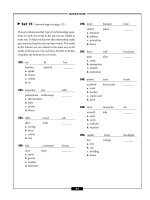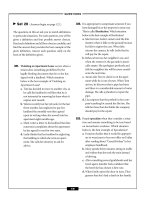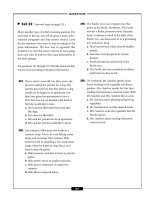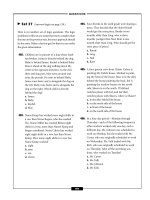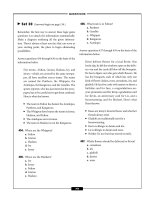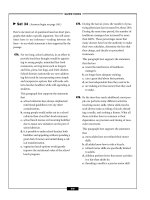logic and boolean algebra - kathleen and hilbert levitz
Bạn đang xem bản rút gọn của tài liệu. Xem và tải ngay bản đầy đủ của tài liệu tại đây (17.99 MB, 141 trang )
Barron's Educational
Sertes,
Inc.
$6.95
LOGC
AND
I
"
hu+dities and
in
the
social and management sciences.
"
1
*
I
Presupposes
only some
high school
algebra
0
Provides
slow
cultivation
of
manipulative
skills
LGE
WOODBURY,
NEW
YORK
All rights reserved.
No part of this book may
be
reproduced
in any form. by photostat, microfilm, xerography, or
any other means, or incorporated into any information
retrieval system, electronic or mechanical, without
the written permission of the copyright owner.
All inquiries should beaddressed to:
Barron's Educational Series, Inc.
1
I3 Crossways Park Drive
Woodbury, New York 11797
Librory
of
Congress Catalog
No.
75-1006
International Standard Book No. 0-81 20-0537-6
tiz~~
aj-e~wrSJs
(la
Lcvitz, Kathleen.
Logic and Boolean algebra.
Bibliography:
Includes tndex.
1. Logic, Symbolic and mathematical.
2,
Algebra,
Boolean.
I.
Levitz, Hilbert, joint author. 11 T~tle.
,.
.
."
,
-
*,.,.,
TO OUR MENTORS
JOE L. MOTT
KURT
SCHUTTE
Contents
PREFACE
vii
INTRODUCTION
viii
1
sentence
Composition
1
1.1 The Basic iogical Operations 1
1.2 Truth Values 2
1.3 Alternative Translations
7
1.4 Converses and Contrapositives 8
1.5 Logic Forms and Truth Tables 9
1.6 Tautologies, Contradictions, and Contingencies 14
1.7 Sentential Inconsistency
15
1.8 Constructing Logic Forms from Truth Tables 16
2
Algebra
of
Logic
21
2.1 Logical Equivalence 21
2.2 Basic Equivalences 23
2.3 Algebraic Manipulation 24
2.4 Conjunctive Normal Form 29
2.5 Reduction to Conjunctive Normal Form 30
2.6 Uses of Conjunctive Normal Form 33
2.7 Disjunctive Normal Form 35
2.8 Uses 6f Disjunctive Normal Form 38
2.9 Interdependence of the Basic Logical Operations 40
3
Analysis
of Inferences 45
3.1 Sentential Validity 45
3.2 Basic Inferences 49
3.3
Checking Sentential Validity of Inferences by
Re
peated
Use
of Previously Proven Inferences 50
4
Switching
Chits 53
4.1 Representing Switching Circuits by Logic Forms 53
4.2 Simplifying Switching Circuits 58
This book was intended for students who plan to study in the hu-
manities and in the social and management sciences. Students in-
terested in the physical and natural sciences, however, might also
find its study rewarding. All that is presupposed is some high school
algebra. The authors strongly urge that the topics be studied in the
order in which they appear and that no topics
be
skipped.
In recent years there has been considerable divergence of opinion
among mathematics teachers as to the degree of abstraction, rigor,
formality, and generality that is appropriate for elementary courses.
We believe that the trend lately has been to go too far in these direc-
tions. Quite naturally, this book reflects our views on this question.
Although the subject matter is considered from a modern point of
view, we have consciously tried to emulate the informal and lucid
style of the better writers of a generation ago. Manipulative skills
are cultivated slowly, and the progression from the concrete to the
abstract is very gradual.
We wish to extend our thanks to our typist Susan Schreck and to
Matthew Marlin and Anne Park, who were students in a course from
which this book evolved. We also wish to thank the editorial con-
sultants of Barron's for their helpful suggestions.
Tallahassee,
Florida
Introduction
Logic is concerned with reasoning. Its central concern is to dis-
tinguish good arguments from poor ones. One of the first persons to
set down some rules of reasoning was Aristotle, the esteemed philoso-
pher of ancient Greece. For almost two thousand years logic re-
mained basically as Aristotle had left it. Students were required to
memorize and recite his rules, and generally they accepted these rules
on his authority.
At the end of the eighteenth century Kant, one of the great philoso-
phers of modern times, expressed the opinion that logic was a com-
pleted subject. Just fifty years later, however, new insights and results
on logic started to come forth as a result of the investigations of
George Boole and others. In his work, Boole employed symbolism in
a manner suggestive of the symbolic manipulations in algebra. Since
then, logic and mathematics have interacted to the point that it no
longer seems possible to draw a boundary line between the two.
During the last forty years some deep and astounding results about
logic have been discovered by the logician Kurt
GBdel and others.
Unfortunately, these results are too advanced to be presented in this
book. We hope that what you learn here will stimulate you to study
these exciting results later.
Finally, we must tell you that complete agreement does not yet
exist on the question of what constitutes correct reasoning. Even in
mathematics, where logic plays a fundamental role, some thoughtful
people disagree on the correctness of certain types of argumentation.
Perhaps someday, someone will settle these disagreements once and
for all.
viii
Sentence Composition
1.1
The
Basic Logical Operations
Compound sentences are often formed from simpler sentences by
means of the five
basic logical operations.
These operations and their
symbols are:
conjunction
A
disjunction
v
negation
1
implication
-,
bi-implication
-
The symbols are usually read as follows:
I
1
II
not
I
SYMBOL
A
I
-,
11
if
then
I
TRANSLATION
and
I
-
11
if
and only
if
I
Note that a good way to keep from confusing the symbols
A
and
v
is to
remember that
A
looks like the first letter of the word "AND."
If
the letters A and B denote particular sentences, you can use the
logical operations to form these compound sentences:
AAB,
read AandB
A
v
B,
read A or B
i
A, read it is not the case that A
A
-+
B,
read if Athen
B
A- B, read AifandonlyifB
2
SENTENCE COMPOSITION
Examples.
Let
A be
the sentence: "Snow is white."
Let B
be
the sentence: "Grass is green."
Then
A A
B is the sentence:
"Snow is white and grass is
green."
Let
A
be the sentence:
"Humpty Dumpty is an egg."
Then
1
A
is the sentence: "It is not the case that
Humpty Dumpty is an egg."
Let
A
be:
"Jack is a boy."
Let
B
be:
"Jill is a girl."
Then
A
-+
B
is: "If Jack is a boy, then Jill is a girl."
Let
A
be: "Birds By."
Let
B
be: "Bees sting."
Let
C
be: "Bells ring."
Then
-I
A
-,
(B
v
C)
is: "If it is not the case that birds
fly, then bees sting or bells ring."
Note that in the last example, the "not" sign applies only to the sen-
tence
A.
If we had wanted to negate the entire sentence
A
-+
(B
v
C),
we would have enclosed it in parentheses and written
1
[A
-
(B
v
C)].
Then it would read, "It is not the case that if birds fly, then bees sting
or bells ring."
A
property of declarative sentences is that they are true or false, but
not both. If a sentence is true, it has
truth
value
t.
If it is false, it has
truth value
f.
You can compute the truth value of a compound sentence
built from simpler sentences and logical operations if you know the
truth values of the simpler sentences. This can
be
done by means of
tables. The table for the conjunction operation is given below. Here is
how to read it. On a given row, the extreme right-hand entry shows
the truth value that the compound sentence
A
A
B should have if the
sentences
A
and
B
have the truth values entered for them in that row.
1.2
TRUTH
VALUES
3
TABLE
FOR
A
("AND")
Examples.
Use the table just given to find the truth values of these
compound sentences:
a) Giants are small and New York is large.
b) New York is large and giants are small.
c) America is large and Russia is large.
ANSWERS:
a) First label each part of the sentence with its own
truth value.
f t
T_-A 7
&
[Glants are small]
A
[New York is large].
Now look in the table to see which row has the values
f, t (in that order) entered in the two left-hand col-
umns. This turns out to be the third row (below the
headings). Looking to the extreme right of that row,
you will find that the entire sentence has the truth
value
f.
b)
Labeling each part with its truth value, we get
Now look in the table to see which row has the values
t, f (in that order) entered in the two left-hand col-
umns. This turns out to
be
the second row. Looking
to the extreme right of that row, you will find that
the entire sentence has the truth value
f.
4
SENTENCE COMPOSITION
C) First label the parts:
t
A
[America is largJ
A
[Russ~a 1s large].
The first row of the table indicates that the entire
sentence has the truth value t.
We make the tables for the other four logical operations in a similar
way:
TABLE
FOR
TABLE
FOR
v
(460~)
-I
("NOT")
TABLE
FOR
-,
TABLE
FOR
-
("IF
.
.
.
THEN
. .
.")
("IF
AND
ONLY
IF
")
According to the table for
v,
the disjunction
A
v
B
is a true sen-
tence if
A
is true, if
B
is true, or if both
A
and
B
are true. Unfor-
tunately, in ordinary conversation people do not always use "or" this
way. However, in mathematics and science (and in this book), the
sentence A
v
B
is considered true even in the case where A and
B
are
both true.
The implication operation presents a similar problem. Quite often
"if A, then
B"
indicates a cause-and-effect relationship as in the sen-
tence:
If
it
rains, thegame will have to bepostponed.
Mathematicians and scientists, however, do not require such a cause-
and-effect relationship in affirming the truth of A
-
B,
and our
1.2
TRUTH
VALUES
5
table has been set up in accordance with their time-honored conven-
tions.
Examples.
Use the tabbs just given to compute the truth values of
the follo&g sentences:
a)AW equals six, then three equals three.
b)
(5
=
7)
v
(6
=
8).
c)
It
is not the case that three equals three.
d)
[(2
=
4)
v
(3
=
3)]
-
[(5
=
0)
A
(6
=
I)].
ANSWERS:
First label the parts with their truth values:
f t
-
&
a) [two equals six]
+
[three equals three]
The third row of the table for
+
shows that the
entire sentence gets the truth value t.
The fourth row of the table for
v
shows that the en-
tire sentence gets the truth value f.
i
[ihree equals three]
The first row of the table for
1
shows that the en-
tire sentence gets the truth value f.
d) This one will involve the use of three tables because
it contains three logical operation symbols.
First label the elementary parts:
From the third row of the table for
v
you can see
that the part to the left of the arrow gets the truth
value t. From the fourth row of the table for
A,
you
6
SENTENCE
COMPOSITION
can
see
that the part to the right of the arrow gets
the truth value f. Now labeling the parts to the left
and right of the arrow with the truth values just com-
puted for them, you have
f
\
From the second row of the table for
+
you can
see that the entire sentence should have the truth
value f.
Exercises
1.2
1.
Let A denote "Geeks are foobles" and let B denote "Dobbies are
tootles." Write the English sentences corresponding to the following:
2.
Let A denote "Linus is a dog," let B denote "Linus barks," and let
C
denote "Linus has four legs." Write each of the following sentences
in symbolic form:
(a)
Linus is a dog and Linus barks.
(b)
Linus is a dog if and only if Linus barks.
(c)
If it is not the case that Linus is a dog, then Linus barks.
(d)
If Linus is a dog, then (Linus barks or Linus has four legs).
(e)
If (Linus barks and Linus has four legs), then Linus is
a
dog.
(f)
(It is not the case that Linus barks) if and only if Linus is a dog.
(g)
It is not the case that (Linus is a dog if and only if Linus barks).
3.
Let A denote
"
1
+
1
=
2"
and let B denote
"2
-
2
=
2."
Use the
tables to find the truth values of the following sentences:
(a) A
v
B (h) B A
-
(b) A
v
1
B (i)
1
A+(~BA A)
(c)
1
A
v
B
(j)
i
A- B
(d)
1
A A
B (k) 1B tA
(e) A
A
-I
B
(1)
(1A
v
B) ~(AA B)
(f)
1A-B
(m)
(B v
A)
v
i
(B
v
A)
(g) lA 1B (n) (B+ A)-(A* B)
t
.
a
t
I
1.3
ALTERNATIVE TRANSLATIONS
7
4.
Let A and
B
be
sentences. Assuming that B has truth value
f,
use
the tables to find those truth values for A which make the following
sentences true,
(a)
5
-+
A
(b) A
A
B
(c) 1A-B
(d)
(A
v
B)
+
B
(e)
(1
B-
A)-
A
1.3
Alternative Translations
In English there are many ways
of
saying the same thing. Here is a list
of some of the alternative ways which can
be
used to translate the
logical operation symbols.
A-B
A
and B Not only
A
but B
A
but
B
A
although B
Both
A
and B
AorB Either
A
or
B
A
or
B
or both
A
and/or
B
[found in legal
documents1
A
doesn't hold
It is not the
case that
A
If
A,
then B.
A
is a sufficient
condition for
B
A
only if
B
B is a necessary
condition for
A
A
implies
B
B provided
that
A
A
if and only
if
B
A
exactly
when
B
8
SENTENCE COMPOSITION
Exercises
1.3
1.
Let A be:
peter is a canary.
Let
B
be:
Joe is a parakeet.
Let
C
be: Peter sings.
Let
D
be: Joe sings.
Translate the following into symbols.
(a)
Joe is a parakeet and Peter is a canary.
=-
3-
(b)
Although Joe does not sing, Peter sings.
(c)
Peter sings if and only if Joe does not sing.
(d)
Either Peter is a canary or
Joe
is a parakeet.
(e)
Peter sings only if Joe sings.
2.
Let M be: Mickey is a rodent.
Let J
be:
Jerry is a rodent.
Let T be: Tom is a cat.
Translate the following into symbols.
(a)
Although Mickey is a rodent, Jerry is a rodent also.
(b)
Mickey and Jerry are rodents, but Tom is a cat.
(c)
If either Mickey or Jerry are rodents, then Tom is a cat.
(d)
Jerry is a rodent provided that Mickey is.
(e)
Either Mickey isn't a rodent or Jerry is a rodent.
(f
)
Jerry is a rodent only if Mickey is.
(g)
Tom is a cat only if Jerry isn't a rodent.
@
onverses and Contrapositives
Suppose you are given an implication
A
+
B.
Two related implica-
tions are given special names.
B
-+
A is called the
converse
of A
+
B.
.
-
1
B
4
i
A is called the
contrapositive
of A
+
B.
The truth value of an implication and its converse may or may not
agree. Below are given some examples to show this. Later you will see
that
an implication and its contrapositive always have the same truth
value.
1.5
LOGIC
FORMS
9
Examples.
Let
A
be:
1
=
2
Let
B
be:
2
is an even number.
Then
A
-,
B
has truth value t, while its converse
B
+
A
has truth value
f.
Let
E
be:
2
is an even number.
'
Let
0
be:
3
is an odd number.
Then E
-,
0
has truth value t, and its converse
0
-
E
also has truth value t.
Exercises
1.4
1.
Let
D
be:
Ollie is a dragon.
Let T
be:
Ollie is toothless.
Let R be: Ollie roars.
Represent each of the following sentences symbolically. Then write
the
9nverse and the con!r_a~ositive.of each sentence, both in symbols
and in English.
(a) If Ollie is a dragon, then Ollie roars.
(b) If Ollie is toothless, then Ollie does not roar.
(c) Ollie roars only if Ollie is a dragon.
2.
Let
A
and
B
be
two sentences. If
A
has truth value t, which truth
value must
B
have to insure that:
(a)
A
-
B
has truth value t?
(b) the contrapositive of
A
-
B
has truth value t?
(c) the converse of
A
B
has truth value t?
3.
Give examples of implications that have truth value t such that:
(a) the converse has truth value
t.
(b) the converse has truth value f.
1.5
Logic Forms
and
Truth Tables
Logical symbolism enables us to see at a glance how compound sen-
tences are built from simpler sentences. Meaningful expressions built
from variable symbols, logical operation symbols, and parentheses
are called
logic
forms.
Capital letters like
A,
B,
C
. . .
can be used as
10
SENTENCE COMPOSITION
the variable,symbols in constructing logic forms. The following are
examples of logic forms:
A-B
B
AvC
(iA-B) B
Note that a single variable symbol is acceptable as a logic form.
Logic forms will often
be
discussed. When talkingabout logic forms,
heavy-type capital leters like
A,
B,
C
(with or without numerical sub-
scripts) will
be
used to denote them. Thus in a given discussion, you
might use the symbol
B
to denote the logic form
Remember:
1.
Heavy type capital letters, like
A,
denote entire logic forms.
2.
Regular capital letters, like A, are variable symbols which appear
in a logic form.
You have already seen that the truth value of a logic form is deter-
mined by the truth values assigned to its variable symbols. Let A and
B be variable symbols. A preceding section contained tables listing the
values assigned to each of the logic forms:
iA AvB AAB A-B AuB
for given truth values of A and B. The tables are examples of
truth
tables.
Using these five tables, you can construct the truth table of
any logic form. As an example, consider the truth table of the logic
form
(A v C)
-,
(B
-+
A).
In each row give an assignment of truth values to the variable symbols
A, B, and C, and at the right-hand end of the row list the value of the
entire logic form for that assignment. The optional columns headed
"A v C" and "B
-,
A" are included to help fill in the table. If you
feel sufficiently confident, you can omit such intermediate columns
when building future truth tables.
1.5
LOGIC
FORMS
I1
TRUTH TABLE
FOR
(A
v
C)
(B
7
A)
+
optional columns
We suggest that you first fill in the columns under the variable
symbols
A,
B,
C
. .
.
and then complete these columns one at a time.
Below are repeated the first three columns of the preceding table.
Note that the places in the columns which have t as entries are shaded,
and observe that there is a pattern to this shading. By following the
pattern you can
be
sure that a logic form with n distinct variable
symbols will have a truth table with
2"
rows and that these rows dis-
play
aN
the possible ways of assigning truth values to the variable
symbols. Note that the top half of the left-hand column consists only
oft entries, the bottom half of
f
entries. In the next column blocks
oft entries and blocks of f entries are alternated; each block consists
of
114
the total number of rows in the table. In the third column, each
block makes up
118
of the total number of rows, etc.
12
SENTENCE COMPOSITION
Exercises
1.5
1.
Construct the truth table for each of the following logic forms:
(a) A
+
1
A (b) (C
A
1
B) v (A
-+
B)
(c) ~(AvC) (d) [(A~B)v(C+~D)]-+(AA~D)
(e) [(B
v
A)
A
C]
-
[(B
A
C) v (A
A
C)]
2.
Use
truth tables to determine the truth value of D, given the fol-
lowing:
(a)
C is true and C
A
D
is true
(b)
C is false and
D
v C is true
(c)
1
D v
1
Cisfalse
(d) C is false and (C
A
D)
-+
(C v D) is true
3.
a) Write a logic form corresponding to the following sentence:
If the stock's value rises or a dividend is declared, then the stock-
holders will meet if and only if the board of directors summons
them, but the chairman of the board does not resign.
b) Determine the truth value of the preceding statement under the
following assumptions by (partially) filling out the truth table for its
logic form.
i)
The stock's valuerises, no dividend is declared, the stockholders will
meet, the board of directors summons the stockholders, and the chair-
man resigns.
ii) The stock's value rises and a dividend is declared, the board of
directors fails to summon the stockholders, and the chairman resigns.
4.
Horace, Gladstone, and Klunker are suspected of embezzling com-
pany funds. They are questioned by the police and testify as follows:
Horace:
Gladstone is guilty and Klunker is innocent.
Gladstone:
If Horace is guilty, then so is Klunker.
Klunker:
I'm innocent, but at least one of the others is guilty.
(a) Assuming everyone is innocent, who lied?
(b) Assuming everyone told the truth, who is innocent and who is
guilty?
(c) Assuming that the innocent told the truth and the guilty lied,
who is innocent and who is guilty?
7
1.5
LOGIC
FORMS
13
[Hint: Let H denote:
Horace is innocent.
Let
G
denote: Gladstone is innocent.
Let K denote: Klunker is jnnocent.
Now symbolize all three testimonies and make one single truth table
with a column for each testimony. The desired information can
be
read from the table.]
5.
Agent
006
knows that exactly one of four diplomats is really a spy.
He interrogates them, and they make the following statements:
Diplomat
A:
Diplomat
C
is the spy.
Diplomat
B:
I
am not a spy.
Diplomat
C:
Diplomat A's statement is false.
Diplomat
D:
Diplomat A is the spy.
(a) If 006 knows that exactly one diplomat is telling the truth, who
is the spy?
(b) If
006
knows that exactly one diplomat's statement is false,
who is the spy?
[Hint: Let
A
denote:
Diplomat A is a spy.
Let
B
denote:
Diplomat
B
is a spy.
Let
C
denote:
Diplomat C is a spy.
Let D denote:
Diplomat D is a spy.
Now symbolize the reply of each diplomat and make a single truth
table with a column for each reply. The desired information can
be
read from the table.]
*6.
A certain college offered exactly four languages: French, German,
Russian, and Latin. The registrar was instructed to enroll each stu-
dent for exactly two languages. After registration, the following facts
were compiled:
i) All students who registered for French also registered for ex-
actly one of the other three languages.
ii) All students who registered for neither Latin nor German regis-
tered for French.
iii) All students who did not register for Russian registered for
at least
two of the other three languages.
iv) No candidate who registered for Latin and German registered
for Russian.
Did the registrar actually follow his instructions?
*This
denotes
a
difficult problem
14
SENTENCE COMPOSITION
[Hint: Let x
be
an arbitrary student at the college.
Let
F
denote:
x registered for French.
Let
G
denote:
x
registered for German.
Let L denote:
x registered for Latin.
Let
R
denote:
x registered for Russian.
Symbolize each of the four facts. Make a truth table with a column
for each of the four facts. Locate the rows for which all four facts
have truth value t. Examine these rows closely.]
1.6
Tautologies, Contradictions,
and Contingencies
Certain logic forms have truth tables in which the right-hand column
consists solely of t's. These forms are called
tautologies.
Hence a
tautology is a logic form which has truth value t no matter what
values are given to its variable symbols. If the right hand column of
the truth table of a logic form consists solely off's, the logic form is
called a
contradiction.
Thus a contradiction has truth value
f
no mat-
ter what values are given to its variable symbols. If a logic form is not
a tautology and not a contradiction, it is called a
contingency.
Example
1.
Tautology:
A
v
1
A
Contradiction:
A
A
i
A
Contingency:
A
-+
B
Notice that if the variable symbols of a tautology are replaced by
sentences, the compound sentence is
always
true.
Example
2.
You have already observed that
A
v
i
A
is a tautology.
Thus the sentence:
A
1
A
A
'it is raininiorct is not raining\
is a true sentence.
The truth of the sentence in this example does not
depend on any facts from meteorology. It is true by
1.7
SENTENTIAL INCONSISTENCY
IS
virtue of the way it is built up from its parts by means
of the logical operations. In other words, it is true by
virtue of its form. Logicians call a sentence like this
one a
substitutive instance
of a tautology.
Exercises
1.6
1.
Make truth tables for the following logic forms. Indicate which
are tautologies, which are contradictions, and which are contingencies.
(a) A
-+
A
(b) A
(B
-+
A)
(c)
(A
v
B)
-,
(A
A
1
C)
(d)
A
v
(
7
A
A
C)
(e) A-+(TAAB) (f)
7
(A AB)-(~A
vl
B)
1.7
Sentential Inconsistency
Let
A,, A,.
.
.
A,
be
a collection of logic forms. These logic forms are
said to
be
sententially inconsistent
if their conjunction is a contradic-
tion. Otherwise, they are said to
be
sententially consistent.
To test a collection of logic forms
A,,
A,.
.
.
A,
for sentential inconsis-
tency, you have only to form their conjunction
A,
A
A,
A
A
A,,
make a truth table for this conjunction, and look to see whether the
right-hand column of the table has all f's. If this is so, then they are
sententially inconsistent. If there is at least one t, then they are
sen-
tentially consistent.
If, after symbolizing a collection of sentences, you find that the re-
sulting collection of logic forms is sententially inconsistent, then you
would know that these sentences are built from their elementary sen-
tences in such a way that it is impossible for all of them to
be
true.
Exercises
1.7
1.
Test the following collection of logic forms for sentential incon-
sistency:
16
SENTENCE COMPOSITION
2.
Symbolize the following sentences and test the resulting logic forms
for sentential inconsistency.
(a) Either a recession will occur or, if unemployment does not de-
crease, wage controls will
be
imposed. If a recession does not
oc-
cur, unemployment will decrease. If wage controls are imposed,
unemployment will not decrease.
(b) If imports increase or exports decrease, either tariffs are im-
posed
or devaluation occurs. Tariffs are imposed when and only
when imports increase and devaluation does not occur. If exports
decrease, then tariffs are not imposed or imports do not increase.
Either devaluation does not occur, or tariffs are imposed and ex-
ports decrease.
3.
After discovering his immense popularity with the American
people, Bagel the beagle decided to run for president. He called to-
gether his top political advisors for a brainstorming session. Out of
this session came the following advice:
Owl:
Beagles can't be president, or the country will go to the dogs.
Fox:
If a beagle can be president, the country won't go to the dogs.
Bear:
Either a beagle can
be
president, or the country will go the
dogs.
Cai:
It's not the case that (the country will go to the dogs and a
beagle can't be president).
Since Bagel's confidence in his advisors was a shade less than ab-
solute, he decided to run a sentential consistency test. What did it re-
veal?
1.8
Constructing Logic Forms from
Truth
Tables
You know that for each logic form a truth table can be made. In this
section you will learn how to reverse the procedure. Here we have a
truth table for an unknown logic form with n given variable symbols.
The problem will
be
to construct a logic form having this given table
for its truth table.
Given the truth table, the following procedure is employed to con-
struct the desired logic form.
1. For each row whose right hand entry is t, make a check markd
to the right of that row.
1.8
CONSTRUCTING LOGIC FORMS
FROM
TRUTH TABLES
17
2.
To the right of each check mark
*/
write a sequence of n terms
(one corresponding to each variable symbol) as follows: if in that
row a variable symbol has the value t entered for it, then the cor-
responding term is to
be
that variable symbol itself; if the variable
symbol has the value f entered for it, then the corresponding term is
to
be
the
negation
of that variable symbol.
3.
To the right of each sequence of terms which you made in step
2,
write the conjunction of those terms.
4.
Beneath the table, form the disjunction of all the conjunctions
which you made in step
3.
The disjunction formed in step
4
will
be
the desired answer.
Example.
Construct a logic form having the following truth table.
tff
ANSWER:
Step
1
I
Step
2
1
Step
3




